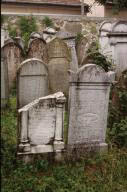|
Romania Journal by Peter Rashkin It was my third eclipse. The first was Mexico in 1991, the second was Paraguay 1994. This time I picked Romania. I thought it would be an adventure. It was. The Romanian countryside in summer was lush and bountiful; people and horses worked together in an agrarian culture still close to its pre-industrial roots. When I decided to go to Romania I knew nothing about the country, except that my mother had been born in what was then Romania (now the Republic of Moldova) and lived there for her first six months while the family waited to immigrate to the US. I could not remember ever having met a Romanian. I made a raid on the library and came back with a ton of books, and began to make contacts through the Internet. We hear a lot of debate about the Internet: Is it just another vehicle for endless consumerism, or can it empower ordinary people in a brand new way? My experience in Romania inclines me to the latter view. First I did a Usenet search and found a Romania forum with this letter: "Hello! I am very sorry for taking a few minutes from your precious time. My name is Calin, I am 26 years old and I am from Romania. If you are interested in the eclipse of the August, I invite you in my country during all this period.....I will propose you a kind of rural tourism to a place called Novaci. The price will be $50 per person a day. Here you will be enjoyed by the splendors of the mountains and also the traditional food..." I responded. He responded. I wrote him a long email about how my mother was born in a Jewish refuge camp and I mentioned some political issues I hoped to pursue, because by then I was fascinated with the Ceasescu period and hoped to interview people about the changes they perceived in their society since his overthrow in 1989. And I didn't hear back from him. By this time I had read a number of reports and memoirs and I knew that anti-Semitism was "on the rise" in Eastern Europe. I also had a stronger picture of the recent repression the country had undergone, and I thought that I had scared the guy off. I began to pursue other travel options. But a month later I got a reply! It hadn't been anti-Semitism or the fear of the thought police that had kept him from answering. Not at all! He just hadn't had access to the Internet. So Calin picked us up at the airport and drove us to his village in the Southern Carpathians, and instead of struggling to arrange food, lodging and transportation in a language we didn't know, we were taken into a family and treated to the most wonderful personal experience. Calin's village, Baia de Fier (iron mine), is in the province of Northern Oltenia, a region still dominated by peasant-based subsistence agriculture. The fields were full of corn, and the people were occupied in making hay for the winter. Horse-drawn wagons loaded high with hay were far more common than pickup trucks, and the ubiquitous claia, the conical haystack typical of the region, added an especially picturesque element to the landscape. Ducks and geese roamed the streets. Every house was surrounded by fields and orchards. Cars shared the road with horses and cattle. Calin's parents were professionals; Elena, a biology teacher, is the principal of the high school. Gigi is a country doctor. (He was on vacation in honor of our visit. That didn't stop patients from showing up on his door at all hours of the night!) Like virtually everyone else in the region, their food came from their land: corn fields, a big vegetable garden, some pigs, some birds. They made their own wine from the grapes that grew in their yard, and from the plums they made tsuika, the justly-famous plum brandy that was offered at every meal. Calin and his brother-in-law spoke a little English; none of the others did. That didn't stop us from having long, far-reaching discussions as we sat around the table laden with barbecue, eggplant salad, mushroom loaf, fresh garden vegetables, cheeses made from cow and sheep milk and, of course, wine and tsuika. I learned that they knew Bob Dylan, the Beatles, Monica Lewinsky and Ken Starr. No one seemed to have heard of Martin Luther King, Jr., or Mahatma Gandhi. We talked about wages and the economy. In fact, the first thing people would ask me was often "How much does a (fill in the blank) make in America?" The Romanian economy is in shambles. The people are cash-poor. The doctor, the school principal and the computer analyst were all drawing the same salary: $150 per month. Workers salaries were around $50 per month, they told me. Yet the prices of many consumer goods were comparable to ours. Gas was about $2 per gallon. During the day, we would go off on adventures in the surrounding countryside. One morning Calin said (I thought) that we were going to the mountains "to see wildlife." We started out of town in his three-year-old Dacia, the national car, now owned by Renault, which sells new for $3000. As we started to climb the mountain we had to stop from time to time and let the motor cool. At one stop we were overtaken by another car with some more of the family. We climbed. Forests alternated with grassy slopes where flocks of sheep grazed. We turned off the paved road and followed some ruts to a grassy knoll, where we stopped and got out. An aggressive dog approached. We grabbed some rocks, just in case. Down in the hollow were some crude wooden huts. A boy came toward us, talked with Elena and called off the dog; we started down the hill. Calin explained the situation. I had misunderstood. It was not "wildlife," we were coming to see, but "wood life," the ancient herder's life that has been virtually unchanged for centuries, if not millennia. The name for it is Transhumantsa. In the summer, they drive their herds up to the high Carpathian slopes to graze. They live in the crude huts, cook over an open fire, make butter and cheese with old fashioned implements. Wood life. In the winter they drive their herds of cattle and sheep, by foot, hundreds of miles to the Danube valley to forage for winter graze. The women and children spend the winter in the villages. That's how they knew Elena, the high school principal, on who's account they welcomed us to their camp, and set out a feast of mamalika (Romanian corn bread) and balmush (a regional corn porridge with cheese, sour cream and butter). The eclipse was spectacular. We watched it from the beautiful 17th century Horezu Monastery, where about 50 people gathered for the event. Calin said it was the epicenter of the eclipse. Not only was it in the lateral center of the 100-mile-wide eclipse path, but it was the center of the eclipse path from the Atlantic to the Indian Ocean.. The sun was obscured for two minutes and 22 seconds. The corona was vibrant; the sky a deep dark eclipse blue; the murmur of the crowd an echo of my own emotions. After the 1994 Paraguay eclipse, someone asked me, "Is it worth it? To go so far for a couple of minutes in the shadow?" I think you know my answer. 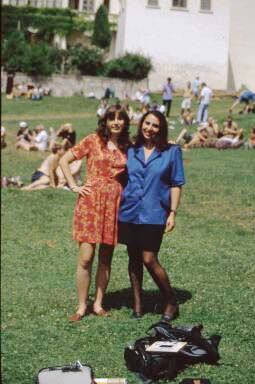 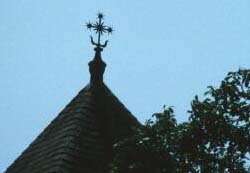 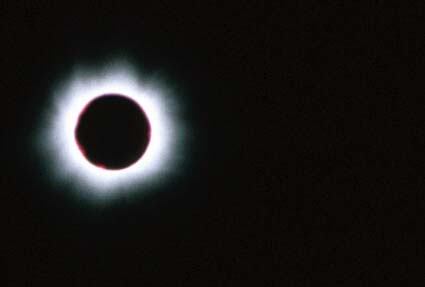 Aug. 11--Eclipse (Click on eclipsed sun to view video) 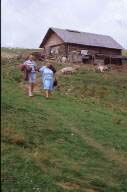 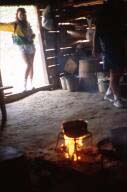 Aug. 12--Transhumantsa...we eat balmush
Aug. 12--Transhumantsa...we eat balmushAug. 13--Two caves and two monestaries Aug. 14--Targu Jiu, Brancusi's home, chess, barbecue Aug. 15--Making Balmush, Drive to Bucarest,Ceasuescu's birthplace Aug. 16--First day in Sighetu Marmatsiei, Jewish Cemetery, Natural History Museum  Aug. 17--Museum of Arrested Thought, Merry Cemetery, Border, Aunt Anna, Birsana Monestary Click Here to view Museum of Arrested Thought video Aug. 18--Interview at synagogue, livestock market, old churches and graveyards of Maramures Aug. 19--Into the Carpathians and Transylvania Aug. 20--Sighisoara, Sinaia Aug. 21--Early morning flight, 8-hour layover in Frankfurt, long flight home |
